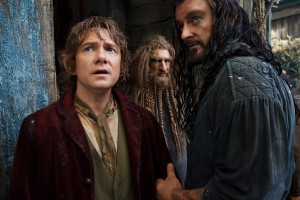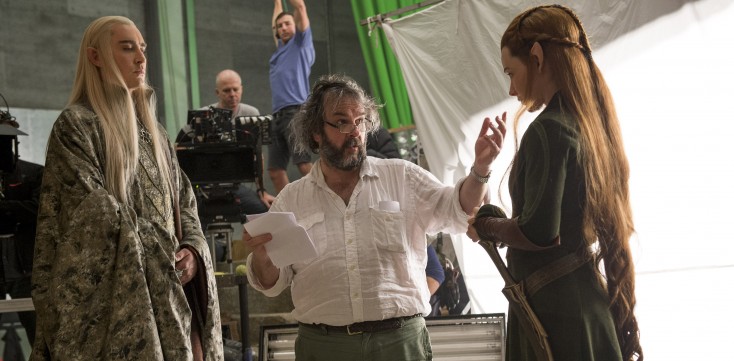
(l-r) Martin Freeman stars as Bilbo Baggins and Richard Armitage as Thorin Oakenshield in “The Hobbit: The Desolation of Smaug.” ©Warner Bros. Entertainment / MGM. CR: Mark Pokorny.
By ANGELA DAWSON
Front Row Features
HOLLYWOOD—Peter Jackson’s “The Hobbit: The Desolation of Smaug” hits theaters just in time for the holidays.
The New Zealand filmmaker returns to Middle-earth with Bilbo Baggins (Martin Freeman) and his band of dwarf companions on their quest to reclaim the Lonely Mountain and the lost dwarf kingdom of Erebot. The adventurers have to overcome a number of obstacles to reach their destination, including battling fierce Wood-Elves, a harrowing escape down a raging river, scaling a treacherous mountain, and most challenging of all, escaping a fire-breathing dragon.
Jackson, of course, is no stranger to the world of fantasy. His highly acclaimed “Lord of the Rings” trilogy was not only a worldwide box office juggernaut, but the films were critically acclaimed for their technical achievement and storytelling. “The Lord of the Rings: The Return of the King,” the 2003 finale in that trilogy earned 11 Academy Awards, including Best Picture, Best Director and Best Adapted screenplay for Jackson and his co-writers Fran Walsh and Philippa Boyens, who also are co-writers on “The Hobbit” films.
Jackson, who filmed all three segments of the trilogy simultaneously, recently spoke about making “Smaug” and working with his cast, which includes many returning and some new faces.
Q: Working on three films simultaneously, how did you distinguish each film esthetically and what changes or adjustments did you make to your approach assembling this film in response to fans from the first “Hobbit?”
Jackson: There wasn’t any ability to respond too much because we had already shot everything pretty much, apart from the 10 weeks of pickups we did this year. Half of that was the third movie. This is a script that was charted from the beginning, and we shot it kind of in chronological order. By the time we were done with pickups, I was just getting in my groove. It was interesting to get completely into the narrative of the story because, as a filmmaker, I was getting swept along with the characters day to day. The filmmaker is on the same journey as the dwarves to some degree over that period of time. The good thing with the middle film is that you don’t have to set things up. You can just drop into the story, assuming that no one is going to see this film that didn’t see the first one. It’s three movies, but it is telling one narrative arc yet you are trying to make each film work individually. This middle part is where you pick up your foot and put it the gas pedal.
Q: What were the unique challenges of the special effects this time around?
Jackson: Any time we were on a green screen stage, I would try to bring in the conceptual artwork that Alan Lee, John Howe or one of the Weta Workshop guys had done, so I was able to at least let the actors know what was going to be on the green screen behind them. Not all the time, though, because sometimes I didn’t even know myself when we were shooting it. Some of those things you figure out later on. Ultimately, it’s the power of your imagination. It’s just suspension of disbelief, really. Just as we ask the audience to believe in a world that elves, dwarves, dragons and orcs exist, when you’re on the stage, you have to be in that same mind frame.
Q: What character benefited the most from the decision to adapt the book into three films instead of two?
Jackson: It’s an interesting question. I don’t think any character benefitted from the decision. We didn’t really change a lot (from the book). We made that decision after we had shot most of the film. It was a decision based on what we had shot. We just thought we were going to have to somehow cut a lot of this stuff out or we could reshape it. So we did some more shooting. We did 10 weeks of shooting this year, as well as pickup shooting for the second and third film. (By spreading the story over two sequels) it allows you to literally let the characters drive the story. In a novel, the writer is often the person who narrates the story. It kind of takes you on the journey. Tolkien’s voice is obviously fantastic at doing that. You feel like he’s right beside you telling you a bedtime story. But in the movie, you don’t want me onscreen telling you what’s happening, so the difference in a film is that you have the story told through the dialogue of the characters and through their actions.
Q: Since “The Hobbit” story precedes “The Lord of the Rings,” did that help you in planning how you would tell the story so the movies would link up at the beginning of “The Lord of the Rings: The Fellowship of the Ring?”
Jackson: You want your narrative of the film to be told through either the dialogue the characters are saying or the actions they do. So that’s really why we ended up giving it the sort of depth it has like we did with “The Lord of the Rings.” I also was acutely aware when we knew there was going to be this cycle of releasing a (“Hobbit”) movie every year, I expected “The Hobbit: An Unexpected Journey” to be the beginning and “The Lord of the Rings: The Return of the King” to be the end, and I wanted to have unity. I didn’t want to make “The Hobbit” feel any simpler (than”LOTR”). I just wanted it to feel like it was the same filmmakers, basically.
Q: How is it directing Martin Freeman as Bilbo Baggins?
Jackson: The one thing about Martin that is amazing is he gives you choices. What that means is that every single take he does is different. He’s just exploring. He’s exploring the whole time. He’s not saying “OK, I think that one was perfect,” I don’t need to go anymore than that. The next take he’s coming up with a different approach to it, and sometimes a very relatively different approach. Ten years ago, after we wrapped on “The Lord of the Rings” shoot with Ian Holm, who played Bilbo as an older man, Ian McKellen came up to me and said, “Are you okay with what he does?” I said “Why?” Ian McKellen is much more of an actor who has a vision for what the scene needs to be about. He’s moving towards that particular goal and Ian Holm was exploring and experimenting. I said, “You both have great approaches. You’re the safe and stable one. I know where you’re heading” So I’m getting a lot of choices with Martin playing the younger Bilbo, who, coincidentally, is exactly the same style actor as Ian Holm.
Q: Evangeline Lilly’s character, Tauriel, was made up for the movie? Why?
Jackson: In the novel, (Bilbo and the dwarfs) get captured by the elves and they escape through the bowels (of the elven prison). That’s a memorable part of the book. But, the elf king isn’t even named (in “The Hobbit”). It was only later on that Tolkien decided he should be (called) Thranduil, and he also decided that he had a son when “The Lord of the Rings” was written, 18 years later. He created the character of the son of the king. So, you have the material there, but you can’t have a scene in a film that’s a memorable scene and not have just one person as the elf. We wanted three elven characters that were all different. The thing is to create characters who have conflict with one another and who have different agendas. I mean (elves) Thranduil, Legolas and Tauriel are all on different flight paths, which makes it more interesting for Fran (Walsh, the co-writer) and I to write the narratives through their eyes.
Q: Can you talk about shooting the scene where the dwarfs are floating down the river in barrels?
Jackson: We had these big V8 water jet things that we built on a circle. It was like a theme park. And we were worried because we thought, how fast can we actually grind, wind the engine up? We could sort of wind it up but we knew we’d better be careful because we didn’t quite know how unpredictable it was. We had stunt guys doing it, round and round, and testing it and everything else, but these are actors, they’re a little bit fragile (He laughs). By the end of the first day, the (actors) were just yelling, “Faster! Faster! Get it faster, faster, faster!” We had the thing going on maximum pretty quickly.
Q: What fantasy action films/shows with cliffhangers impressed you as a youngster?
Jackson: When I was 17 or 18 years old, I remember “The Empire Strikes Back” cliffhanger. It was, like, three years before the next one came out. We’re being pretty generous with one year (to answer the cliffhanger question). As a “Breaking Bad” fan, I was hanging a long time for that last half season for the “Breaking Bad” finale.





